Summary of the Picos de Europa Lepidoptera Study, 2008
Teresa Farino
04/03/2009 15:44:58
Between January and November 2008, our survey team recorded 114 species of butterfly and 271 species of macromoths in the Picos de Europa and immediate environs.
Posted in: Butterflies and Moths, Endangered Wildlife and Habitats | Asturias, Cantabria, Castile-Leon | Mainland Spain, Northern Spain
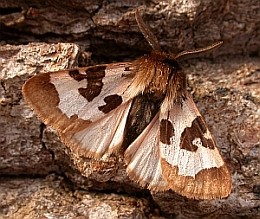 Chaste Pellicle
Chaste Pellicle
Watsonarctia casta© Teresa FarinoLaunched by Teresa Farino in 1989, this study of the butterflies and macromoths of the Picos de Europa is centred on the valley of Liébana, in the south-eastern corner of the range, extending as far south as the Puerto de Piedrasluengas, in Palencia, and to the Valdeón valley in León to the west.
In 2008, three surveyors – Teresa Farino, John Barkham and Steve Whitehouse –made 3,028 field observations – 1,903 of butterflies and 1,125 of macromoths – during 124 days/nights, in 61 1km x 1km UTM squares. Between January and November, we detected the presence of 114 species of butterflies and 271 species of macromoths. These figures represent 73.5% of the 155 butterflies cited to date as being present in the Picos de Europa, but only 43% of the 632 macromoths recorded since this study began.
Butterflies
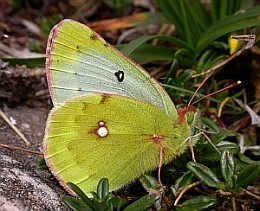 Mountain Clouded Yellow
Mountain Clouded Yellow
Colias phicomone© Teresa FarinoIt seems that the paucity of snow in the high mountains during the winter of 2007–2008 had a negative effect on the high-mountain butterfly fauna; the absence of an insulating blanket of snow subjects the overwintering larvae or pupae of these species to severe frosts. Imagos of species such as Apollo (Parnassius apollo), Mountain Clouded Yellow (Colias phicomone), Mountain Dappled White (Euchloe simplonia), Western Brassy Ringlet (Erebia arvernensis) and Gavarnie Blue (Agriades pyrenaicus asturiensis) were present in much reduced numbers, and appeared much later than would normally be expected. More worryingly, we made no observations of such typical high-altitude species such as Shepherd’s Fritillary (Boloria pales), Lefèbvre’s Ringlet (Erebia lefebvrei astur) or Mountain Ringlet (Erebia epiphron).
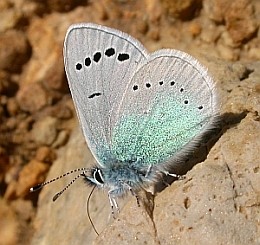 Green-underside Blue
Green-underside Blue
Glaucopsyche alexis© Teresa FarinoA further setback to the butterflies of the region was the deluge of almost biblical proportions that affected the Picos during the whole of May and first half of June. Many normally commonplace species were observed on three or fewer occasions during the course of the year, including Marbled Skipper (Carcharodus lavatherae), Silver-spotted Skipper (Hesperia comma), Olive Skipper (Pyrgus serratulae), Provence Orange Tip (Anthocharis euphenoides), Large White (Pieris brassicae), Bath White (Pontia daplidice), Camberwell Beauty (Nymphalis antiopa), High Brown Fritillary (Argynnis adippe),Small Pearl-bordered Fritillary (Boloria selene), Lesser Marbled Fritillary (Brenthis ino), Esper’s Marbled White (Melanargia russiae cleanthe),Blue-spot Hairstreak (Satyrium spini), Purple-shot Copper (Lycaena alciphron), Green-underside Blue (Glaucopsyche alexis) and Duke of Burgundy Fritillary (Hamearis lucina).
In addition, typical Picos species such as Cardinal (Argynnis pandora), Large Ringlet (Erebia euryale), Dusky Heath (Coenonympha dorus) and Large Chequered Skipper (Heteropterus morpheus) were notable only by their absence.
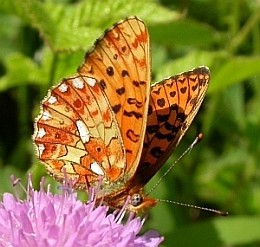 Pearl-bordered Fritillary
Pearl-bordered Fritillary
Boloria euphrosyne© Teresa FarinoNevertheless, the prolonged period of fine weather earlier in the year led to a noticeable advance in the flight period of several species with respect to previous years. For example, Clouded Yellows (Colias crocea) were on the wing in January and February; Red-underwing Skippers (Spialia sertorius), Wood Whites (Leptidea sinapis), Berger’s Clouded Yellows (Colias alfacariensis) and Green Hairstreaks (Callophrys rubi) appeared in March; and Small Skippers (Thymelicus sylvestris), Pearl-bordered Fritillaries (Boloria euphrosyne), Glanville Fritillaries (Melitaea cinxia), Knapweed Fritillaries (M. phoebe), Small Blues (Cupido minimus), Turquoise Blues (Polyommatus dorylas) and Adonis Blues (Lysandra bellargus) were seen for the first time in April since this study began.
A few outstanding records for the 2008 season are as follows, although their exact locations are not given here, so as to safeguard populations of these sensitive species:
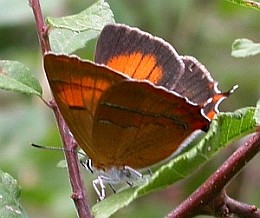 Brown Hairstreak
Brown Hairstreak
Thecla betulae© Teresa Farino• Tufted Marbled Skipper (Carcharodus flocciferus) was recorded for the first time during this study, at a site in Cantabria, although it has previously been cited by other authors as being present in the Picos de Europa.
• Our 2004 record of an isolated individual of Bog Fritillary (Boloria eunomia) at a site in León was verified by the detection of a recently emerged imago in the same place on 5 July this year, which suggests that a previously unpublished breeding colony is present in the area. However, we did not detect the presence of this species in 2008 in its better-known locality within our study area.
• Dusky Large Blue (Maculinea nausithous) was recorded on two occasions - eight days apart - at a site in León that we have been monitoring since the study began.
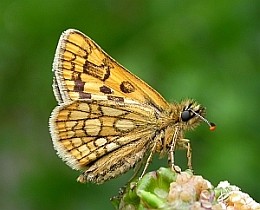 Chequered Skipper
Chequered Skipper
Carterocephalus palaemon© Teresa Farino• A single male Large Blue (Maculinea arion) was observed at a locality in Cantabria where its presence was previously unknown, although the better-known sites did not turn up any individuals.
• Brown Hairstreak (Thecla betulae) was again located in two separate colonies in lowland Cantabria, which we have been monitoring for the past four years.
• During our monitoring of the known colonies of Chequered Skipper (Carterocephalus palaemon) and Woodland Brown (Lopinga achine) in a single Cantabrian locality, we turned up just one individual of the former (an earlier-flying species, undoubtedly affected by the persistent rain), but the latter was present in some numbers in early July.
Macromoths
The prolonged rain in May and early June also affected moth catches at our principal trapping site in Pesaguero (Cantabria), being reflected in the low numbers of both species and individuals attracted to the light. Nevertheless, during the course of the year we recorded no less than 17 species that are new to our study (identifications verified by Colin W Plant).
New Species of Macromoths for the Picos de Europa Lepidoptera Study in 2008
DrepanidaeCilix hispanica (Spanish Character)
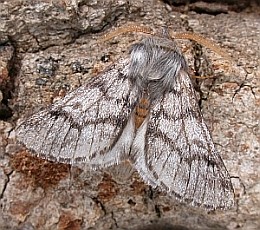 Eastern Pine Processionary
Eastern Pine Processionary
Thaumetopoea pinivora© Teresa FarinoGeometridae Bichroma (Isturgia) famula (Frosted Broom)
Epirrhoe rivata (Wood Carpet)
Cyclophora ruficiliaria (Jersey Mocha)
Idaea mediaria (Slender Sand-wave)
Scopula (Idaea) rubiginata (Tawny Wave)
Hydriomena furcata (July Highflyer)
Perizoma albulatum (Grass Rivulet)
Chesias isabella (Isabelle’s Chevalier)
Peribatodes perversarius (Sallow Beauty)
Clorissa viridata (Small Grass Emerald)
Nychiodes notarioi (Swarthy Annulet; see
Nychiodes in the Iberian Peninsula)
ThaumetopoeidaeThaumetopoea pinivora (Eastern Pine Processionary)
Noctuidae Zanclognatha (Herminia) lunalis (Jubilee Fanfoot)
Omia cymbalariaeAnarta myrtilli (Beautiful Yellow Underwing)
Hecatera weissi  Omia cymbalariae© Teresa FarinoOmia cymbalariae
Omia cymbalariae© Teresa FarinoOmia cymbalariae, Frosted Broom and Grass Rivulet are day-flying species, and were recorded in several localities in Cantabria, while the remainder came to the Robinson trap powered by an 80W MV bulb in Pesaguero, also in Cantabria. Frosted Broom is considered to be in recession throughout Europe, while Slender Sand-wave is an interesting record for Pesaguero, as it is typically a species of hot, dry habitats, and has not previously been recorded this far west in northern Spain.
During our week-long butterflies and moths tour of the Picos de Europa in July 2008 we recorded 101 species of butterflies and 130 macromoths. Please click on the link for details of forthcoming Lepidoptera tours in the Picos.
Don’t forget that in Spain it is ILLEGAL to use a butterfly net or moth trap without a permit from the relevant authorities, even if you do not take specimens.
Related Information:
Details of Teresa's annual butterflies and moths holiday in the Picos de Europa
Read more blog posts